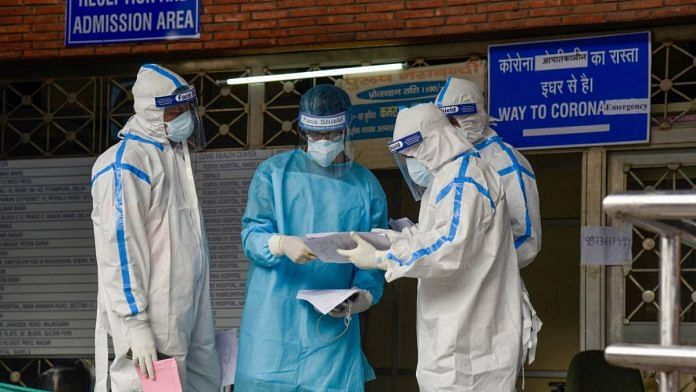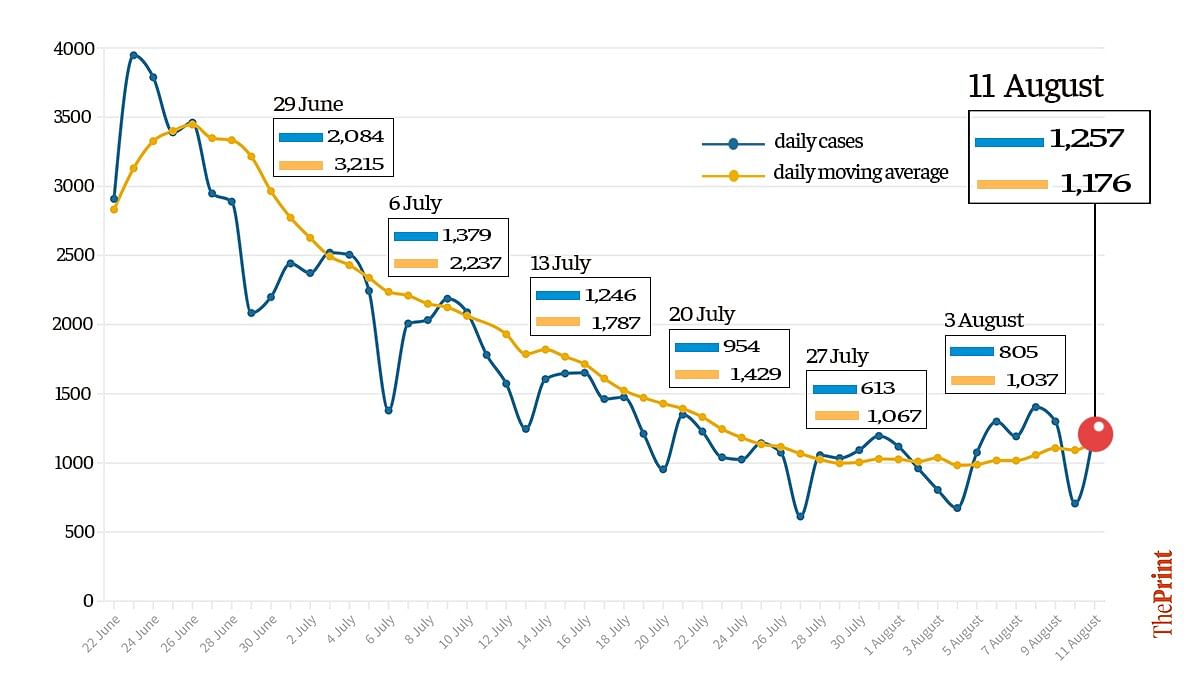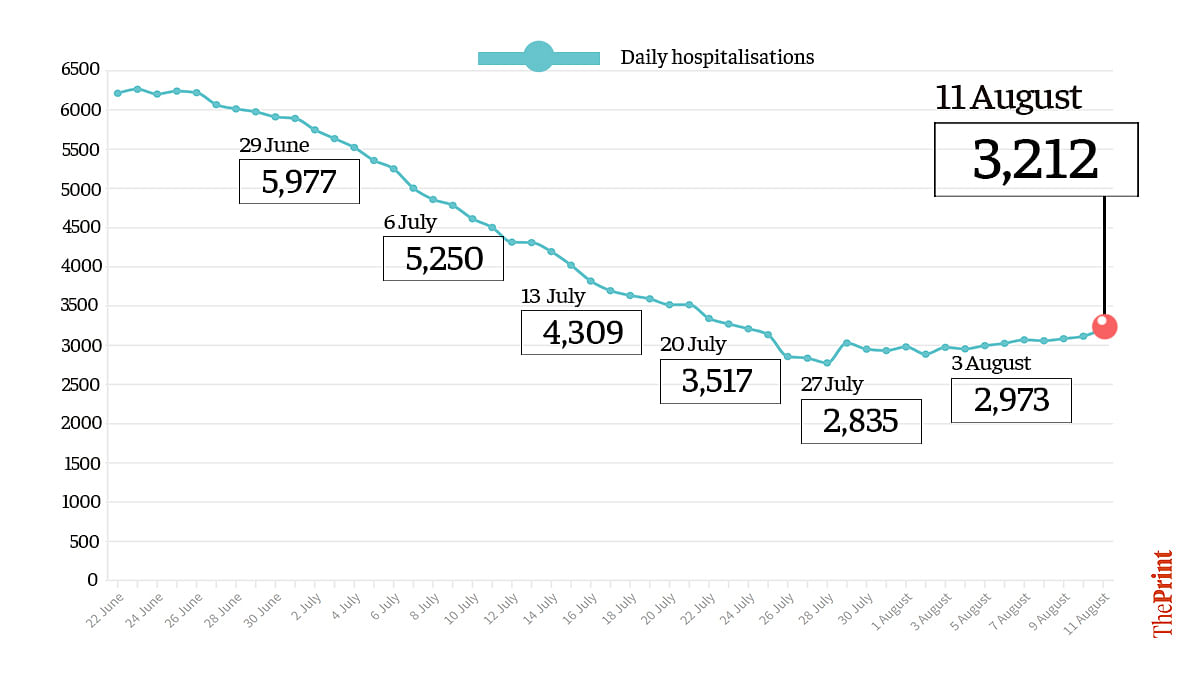New Delhi: Just days after Prime Minister Narendra Modi cited the Delhi-NCR model as an example of good Covid management, latest data could cast a shadow on the national capital’s success story.
After recording a decline in positive cases of the novel coronavirus for a month, in the last week, the city has started to show an upward trend, data analysed by ThePrint has shown.
Both daily cases as well as hospital admissions noted an increase in the period between 5-11 August, government data shows.
The Arvind Kejriwal government, however, has maintained that the national capital is still doing well and the spike in cases is only due to patients coming from other states.
As of 14 August, Delhi recorded 1,49,460 cases in total, of which 4,167 were deaths and 1,34,318 had recovered.
Daily cases above 1,000 again
Daily cases have consistently been above the 1,000-mark in the period between 5-11 August, barring just one day (10 August).
Delhi noted 1,076 (5 August), 1,299 (6 August), 1,192 (7 August), 1,404 (8 August), 1,300 (9 August), 707 (10 August) and 1,257 (11 August) cases. Before the surge, daily cases had dropped to 674 as of 4 August.
The seven-day daily moving average (average of daily cases over seven days) also increased in the past week. According to data available on Covidtoday.in, this moving average increased from 988 on 5 August to 1,176 on 11 August.
In comparison, daily cases began their downward trend around 22 June, when 2,909 were recorded, falling to 2,084 on 29 June, and further to 1,379 on 6 July.
Barring four days i.e., from 7-19 July during which time daily cases crossed 2,000, the numbers remained below 1,000 for the rest of the month. During this four-day spike, the daily tally was recorded as follows: 2,008 (7 July), 2,033 (8 July), 2,187 (9 July) and 2,089 (10 July).
From 11 July onwards, cases again began dipping. Numbers consistently dropped from 1,781 (11 July) to 1,475 (18 July ). After a fluctuation between 19 July (1,211) and 20 July (954), cases again continued to drop, recording 1,349 (21 July) and further falling to 1,056 (28 July).
The trend continued with 1,035 cases being recorded on 29 July, and going as low as 674 on 4 August. However, this is where the trend began changing, rising to 1,076 on 5 August.
Also read: One in four people in Delhi infected by Covid till first week of July, sero survey finds
Rise in hospital admissions
In terms of hospital admissions, government data revealed that Delhi noted an increase in the past week, with total numbers hovering above 3,000 in comparison to the previous week, where the numbers remained lower than that.
In the period between 5-11 August, daily admissions increased to 3,212 on 11 August from 2,995 on 5 August. The daily admissions in this period were recorded as 2,995 (5 August), 3,024 (6 August), 3,069 (7 August), 3,058 (8 August), 3,084 (9 August), 3,115 (10 August) and 3,212 (11 August).
In comparison, daily admissions in the previous week remained below 3,000. In the period between 29 July and 4 August, daily admissions were recorded as 3,028 (29 July), 2,950 (30 July), 2,932 (31 July), 2,979 (1 August), 2,886 (2 August), 2,973 (3 August) and 2,954 (4 August).
Going back further, data on daily hospitalisations shows a declining trend from June through July. Numbers had dropped from 6,213 on 22 June to 5,977 on 29 June, and further to 5,250 on 6 July.
By 13 July, the numbers consistently dipped to 4,309, on 20 July they were at 3,517, dropping lower to 2,835 on 27 July and 2,775 on 28 July.
However, there was an increase on 29 July, with hospital admissions going up to 3,028. Nevertheless, between 30 July and 4 August, hospitalisations remained below 3,000 as mentioned above. From 5 August onwards, daily hospitalisations once again rose above 3,000.
Also read: Covid patients say Delhi private hospitals still overcharging, ignoring govt rate caps
Delhi govt points to patient influx from other states
At a press conference Wednesday, Delhi Health Minister Satyendar Jain said the surge in cases and admissions was due to patients coming from other states.
“One-third patients admitted in Delhi hospitals have come from other states. Till 15 days ago, Delhi’s daily admissions were only about a 100. But now over 100 patients are coming from other states, which is reflected in the spike,” he said.
Doctors ThePrint spoke to also said there had been an increase in admissions of patients from other states. Delhi’s largest Covid facility, the govt-run Lok Nayak Jayprakash Narayan Hospital, too, has noted an increase in admissions in the past week.
“Admissions have increased by 8-10 per cent in the last week. We are getting a lot of patients from NCR regions like Ghaziabad, Bulandshahr and Noida,” Dr Suresh Kumar, director, LNJP Hospital, told ThePrint.
“Urban mobility has increased. Patients in neighbouring states that don’t have facilities like Delhi are coming to Delhi for treatment and that’s adding to Delhi’s tally,” said Dr D.S. Rana, chairman of privately-run Gangaram Hospital, which has been converted into a Covid facility.
However, the Delhi government said that despite the slight surge, the national capital need not worry.
“Our recovery rate is still above 90 per cent, so things are improving in Delhi and because Delhi has plasma therapy available as well, a lot of patients from other states are coming here,” said health minister Jain, who himself had received plasma therapy after contracting the disease.
Also read: Plasma therapy: The experimental Covid therapy Delhi Health Minister Satyendar Jain received









What a stupid article, the no of cases on 3rd and 4th August were under 1000 because tests done were less (10000). On all other days around 20000 tests have been done apart from 10th, so the cases were less. Positivity factor and mortality rate are better parameters for making comment on the condition of pandemic in a certain area. Increases in no. Of cases only give half the picture.
Delhi did well for even a shorter period of time than it meets the eye. If one carefully watches the trend of testing numbers in Delhi, one would get a true image of the thungs which are hiding behind absolute case numbers. If a second intervention would be needed by the Centre, then Mr. Clean Politician would have to face lotsof questions
We have seen maximum rise in COVID-19 POSITIVE cases in National Capital in 3rd week of June. Immediate after we had changed our Management Team, we had changed our Gold-Standard RT-PCR COVID-19 Platform and introduced Nonstandard RADT (RAPID ANTIGEN DETECTION TEST) PLATFORM. As per WHO criteria, a platform having high False Negativity, which should not be used for screening of COVID-19 and will be used for Research and Development Purposes only. Afterwards, we have introduced the same (except few states) almost all States and UT’s. For our satisfaction, liked the cost per test of COVID-19 , we have got the initial success.
From the very beginning, we know that we are ineluctable and that is what presented over here.
In our Childhood, we had heard “A stitch in time saves Nine.”
In University, we had Understood ” There is no shortcut.”